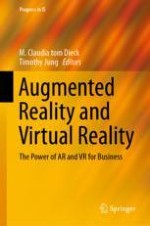2019 | OriginalPaper | Buchkapitel
What We Don’t Know. The Effect of Realism in Virtual Reality on Experience and Behaviour
verfasst von : Marnix van Gisbergen, Michelle Kovacs, Fabio Campos, Malou van der Heeft, Valerie Vugts
Erschienen in: Augmented Reality and Virtual Reality
Aktivieren Sie unsere intelligente Suche, um passende Fachinhalte oder Patente zu finden.
Wählen Sie Textabschnitte aus um mit Künstlicher Intelligenz passenden Patente zu finden. powered by
Markieren Sie Textabschnitte, um KI-gestützt weitere passende Inhalte zu finden. powered by
